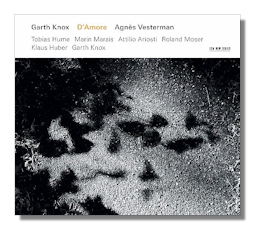
The Internet's Premier Classical Music Source
Related Links
- Marais Reviews
- Latest Reviews
- More Reviews
-
By Composer
-
Collections
DVD & Blu-ray
Books
Concert Reviews
Articles/Interviews
Software
Audio
Search Amazon
Recommended Links
Site News
 CD Review
CD Review
D'Amore

Works for Viola d'amore
- Garth Knox: Malor me bat 1
- Marin Marais: Les Folies D'Espagne 1
- Roland Moser: Manners of Speaking
- Tobias Hume: A Pavin
- Attilio Ariosti: Prima Lezione
- Klaus Huber: …Plainte…
- Traditional:
- Celtic Dance 1
- I Once Loved a Lass 1
- Jig 1
Garth Knox, viola d'amore
1 Agnès Vesterman, cello
ECM New Series 1925 (4766369) DDD 54:06
To play the viola d'amore and to specialize in contemporary classical music is a nest of contradictions. That's exactly what Irish-born Garth Knox does, however, although he remains active as a violist as well. (Between 1990 and 1998 he played that instrument in the Arditti String Quartet.)
This is the first CD in which Knox's work with the viola d'amore is front and center. The repertory is a combination of the old and the new – a combination, I might add, that seems to have special appeal for ECM New Series and producer Manfred Eicher as well. Furthermore, the new clings to the old, and the old grasps for the new. That's a contradiction one also expects and welcomes from ECM New Series.
The viola d'amore is a seven-stringed bowed instrument about as large as a viola, and with a similar range. What makes it particularly unusual is the fact that each string has a sympathetic string underneath it. These strings are not bowed, but vibrate "in sympathy" when the main strings are bowed. The vibration of these sympathetic strings is credited for the instrument's characteristically mellow tone. The instrument's heyday was during the late 1600s and the 1700s. Modern composers have continued to write for the instrument, though, when they are looking for a particular sound. Bernard Herrmann, for example, used it in his score for the 1971 film Night Digger.
Knox's program is challenging but not sonically threatening. His instrument's warm tone counteracts the prickliness of his own Malor me bat (a fantasy of sorts, based on a tune once attributed to Ockeghem) and Roland Moser's Manners of Speaking. Both the latter work and Klaus Huber's …Plainte… introduce scordatura effects, in which some of the strings are re-tuned. The presence of Agnès Vesterman's cello in several of these works also softens the sonic bite that they otherwise might have had. The performers' arrangement of Marais's Les Folies d'Espagne is gritty and fun; the tune is the famous "Folia" that many composers have toyed with through the ages. Knox's sound also has plenty of texture in Hume's grave Pavin (Pavane). Attilio Ariosti is remembered (when he is remembered at all) almost exclusively for his compositions for viola d'amore, and it is fitting that he be represented here by one of his Lessons, which are of more than simply pedagogical value. It's surprising how big the sound of the viola d'amore can be! I am not sure that the three traditional works "go" with the rest of the program all that smoothly, but they do give Knox and Vesterman a chance to let their hair down, and show their best country manners!
The microphones bring the performers close, and in the case of Knox, this is particularly helpful for appreciating the special characteristics of his instrument. The booklet notes are by Knox and Paul Griffiths, both of them good tour-guides who helpfully point out the important landmarks.
Copyright © 2008, Raymond Tuttle




















